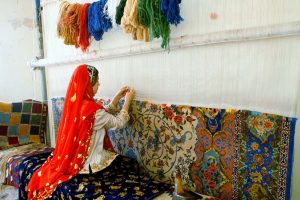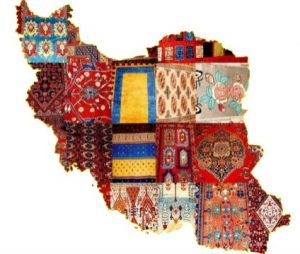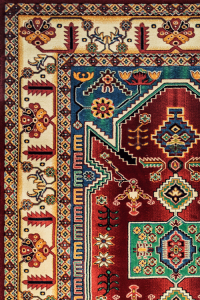The Persian rug or Persian carpet is a name for a handmade rug from Persia / Iran. Persian carpets are counted among the early applied arts. The use of rugs for the decoration of the temple is already mentioned in the Bible. The oldest known knotted carpet is the so-called Pazyryk. A Persian or oriental rug is a rug made by hand (see carpet knots), machine-made rugs do not belong to this group. If you intend to buy Persian rug this guide can help you finding the best authentic hand-knotted Persian rug that fits you.

The Persian handmade (hand-knotted) carpet is woven by the hands of nomadic artists, either by skilled hands of Persian urban or suburban people. The Persian carpet is the result of thousands of wool knit or silk knits that are carefully trimmed around each warp.
Each carpet has its own unique design and story and some Persian carpets are woven from complicated patterns. Some Persian carpets are knotted just by its weavers’ creative nature and are inspired by the surrounding natural environment and the way of life.
After weavers knotted each knot with a suitable colored thread according to the pattern map and completed a row, they knock on the newly knotted knots so that the knots were fixed and the previous ridge and the new ridge were separated. Weaving a carpet takes months or even years and the buyer takes a beautiful, durable and functional to home.
The Persian carpet is recognized as a symbol of Iranian originality and art throughout the world and has many fans around the world, with about one-third of the world’s hand-knotted carpets being woven in Iran.
The Persian carpet is the favorite style of any kind of people and decoration designers due to its variety. Also, one of the hallmarks of Iranian handmade carpets is its high quality, and as a result, old Persian carpets that have remained for many years have more material and spiritual value than other carpets.
In most Persian carpets, cotton is used as warp and woof and warp beam, although in some tribal rug wool is used as warp and woof, and in silk rugs, silk and sleave are often used for warp and woof and texture. Usually wool, silk, and cotton are used for Iranian carpet weaving, however, sometimes camel wool or goat wool is used in nomad carpets.
The classification system based on geographical area and carpet quality is used throughout Iran.

Persian carpets are classified according to the region where the carpet is woven. For example, Tabriz Carpet is a carpet woven in or near Tabriz city. Of course, an important carpet center like Tabriz has subframes like Tabriz fish.
Each city, village, or tribe has its own carpet weave, which is almost like the brand of that area. If a pattern is well-known, other centers will try to mimic it, although copying will never be the same as the original.
Sometimes a carpet known as a particular city is not woven in that city, because the quality of the carpet is also a decisive factor. For example, delicate carpets that are woven in the city of Mashhad, are often famous as the mod carpet, the mod is a small village near Mashhad, and a carpet that has the name of the mod is not necessarily woven in the mod.
Another method for categorizing carpets is a classification based on the city where the carpet is sold. For example, Arak is a small city that has one of the most famous carpet markets. Arak is among the dozens of villages where carpets are widely woven there. The villagers are sending carpets to Arak for sale, and thus these carpets are called Arak carpets. Similarly, Birjand is also a city in the southern Khorasan province and far from Mashhad, but some carpets that have a certain quality and are sold in Mashhad are called Birjand carpets.

Persian carpets can be divided into general categories of tribal or nomadic and urban. The tribal carpets are woven into the hands of the elders and residents of the small villages. In general, carpets of nomads have a lower quality than urban carpets. However, materials such as wool and dyes used in carpet weaving have the highest quality, and generally, the tribal carpets are very impressive.
Dyes used in nomad carpets are mainly from vegetable and are better than chromic or chemical dyes. Persian carpets have very diverse designs. Native rug usually has a geometric design, with few details and just a few bright colors.
While urban carpets have a more detailed pattern, they have a lot of different colors. In addition, some cities have only a few patterns, while large cities such as Tabriz have pattern mines! The carpet experts can usually determine the carpet’s origin according to its pattern.
Get informed about exclusive sales , free delivery and discount coupons %